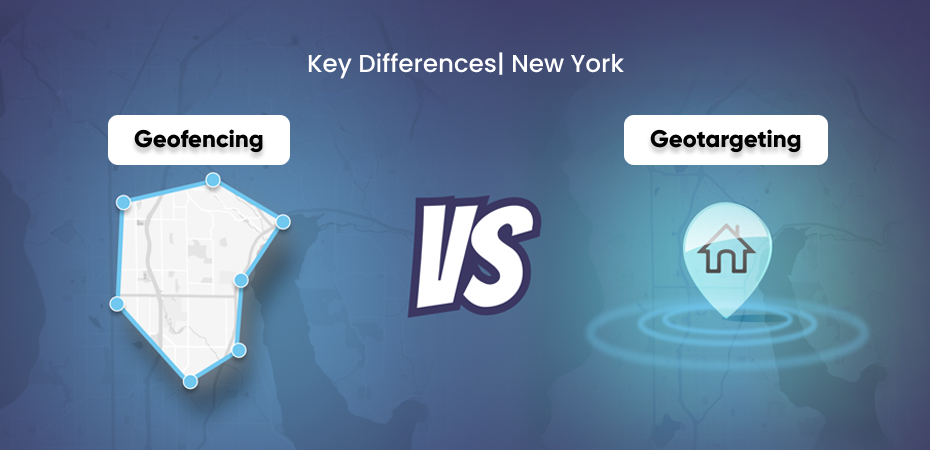Geofencing vs. Geotargeting: Key Differences| New York



Introduction
In today’s digital world, using location-based marketing is more important than ever. Thanks to smartphones and GPS technology, businesses can now reach customers based on where they are. Two popular ways to do this are geotargeting and geofencing. Both use location data, but they work in different ways and offer different benefits.
For businesses in New York—a busy, competitive city with a wide range of customers—knowing how to use these tools can make a big difference. In this blog, we’ll explain what geotargeting and geofencing are, how they differ, and how your New York business can use them to improve your marketing. Let’s get started!
Understanding Geotargeting
Geotargeting- Definition and Benefits
Geotarget marketing refers to the practice of delivering content, advertisements, or offers to users based on their geographical location. It involves using data like IP addresses, GPS, or Wi-Fi signals to identify a user’s location, and then tailoring marketing efforts to match that location.
For example, if you run a restaurant in Brooklyn, New York, geo-target marketing would allow you to show ads or promotions specifically to users located near your restaurant. It’s an effective way to ensure that your marketing messages are relevant to the people most likely to engage with them.
How Geotargeting Benefits Businesses
- Increased Relevance: By targeting users in specific regions, businesses can ensure that their messages resonate with the right audience.
- Cost-Effective: Geotargeting helps reduce wasted advertising spend by focusing efforts on people who are most likely to convert, whether they are nearby or in a particular zip code.
- Better Engagement: Tailoring content for a particular geographic area can increase customer engagement and drive more foot traffic to physical locations or boost online sales.
Applications of Geotargeting in New York
For New York businesses, geographic targeting can be particularly beneficial due to the city’s dense population and diverse consumer base. A local clothing boutique might use geo-targeting to advertise sales specifically to people in the Soho area, while a taxi service can target customers within a specific neighborhood in Manhattan.
Geo-fencing- Meaning and Benefits
Understanding Geofencing Technology
Geo-fence marketing takes geotargeting a step further by creating virtual boundaries around specific locations—such as a store, event, or landmark—and triggering actions when a user enters or exits that zone. It relies on GPS, RFID, or Wi-Fi signals to detect when someone enters or leaves the defined area.
For instance, if a customer walks into a mall, a retailer could send them an instant notification about a special promotion or discount just for that location.
Geofencing Use Cases
- Retail Stores: Sending push notifications or special offers to customers when they enter the store.
- Events: Event organizers can send reminders, updates, or exclusive content to users as they approach or enter an event venue.
- Local Services: A nearby coffee shop could send a promotional message to users when they walk near the shop, encouraging them to stop by.
Benefits of Geofencing for New York Businesses:
- High foot traffic areas like Manhattan offer ideal conditions for geofence marketing campaigns.
- Helps businesses engage potential customers in real time as they move through the city.
- Perfect for retail, dining, and service-based businesses targeting nearby foot traffic.
- Encourages spontaneous purchases and increases walk-in traffic during peak hours.
- Enhances customer experience with timely, location-relevant promotions.
Example: A coffee shop in the Financial District can send limited-time offers to office workers walking by.
Key Differences Between Geotargeting and Geofencing: Geotargeting vs Geofencing
Scope of Reach
- Geotargeting: Targets users within a broader geographic area. For example, businesses can target customers based on a city, region, or even a specific zip code.
- Geofencing: Targets users within a specific, predefined area. The “fence” could be a few blocks around a store or a set radius around an event location.
Technology and Trigger Mechanisms
- Geotargeting: Relies on targeted location data such as IP addresses, Wi-Fi networks, or GPS signals to identify users and deliver content.
- Geofencing: Uses GPS or RFID technology to create virtual boundaries around a specific location. When a user enters or exits the defined area, an action (such as sending a notification) is triggered.
Level of Personalization
- Geotargeting: Allows for broad targeting based on regions, meaning it is ideal for tailoring content to large areas like cities or states.
- Geofencing: More personalized and immediate, as it targets users based on their real-time physical presence in a location, making it perfect for time-sensitive offers.
Effectiveness in Different Industries
- Geotargeting is effective for businesses with a broad geographic reach, such as e-commerce stores or regional service providers. It works particularly well for local SEO strategies aimed at targeting specific geographic regions.
- Geofencing works best for brick-and-mortar businesses and events where physical presence is important. Retailers, event organizers, and local service providers benefit the most from geofencing.
User Engagement Timing
- Geotargeting: Engagement is typically delayed and driven by broader ad delivery schedules or browsing behavior. It’s used more for awareness and consideration phases of the customer journey.
- Geofencing: Engagement happens in real-time as users cross into or out of the defined boundary, making it ideal for triggering impulse actions or immediate conversions.
Data Collection and Insights
- Geotargeting: Provides insights based on general location trends, such as which regions are driving the most traffic or conversions. This is valuable for strategic planning and ad budget allocation.
- Geofencing: Offers granular data such as dwell time, visit frequency, and foot traffic patterns. This helps businesses refine physical location strategies and measure offline conversion impact more accurately.
Tools for Geotargeting and Geofencing
Top Tools for Geotargeting
- Google Ads: A powerful platform that allows you to geo-target ads based on a user’s location.
- Facebook Ads Manager: Offers geotargeting features that let businesses target users by city, region, or even specific locations.
- SEMrush: While primarily an SEO tool, SEMrush can be used for geotargeting in paid search campaigns to focus on specific geographic areas.
Top Tools for Geofencing
- Radius Networks: Provides tools for creating geofences and triggering actions when users enter or exit these boundaries.
- Geofeedia: A social media monitoring tool that uses geofencing to track location-based social media activity in real-time.
- Bluedot: A geofencing tool that helps businesses engage customers with location-based advertising in real-time.
Choosing the Right Tool for Your Business
Choosing between geotargeting and geofencing tools depends on your business’s needs. For broader advertising campaigns that target entire regions, geotargeting tools like Google Ads and Facebook are perfect. For businesses that need real-time engagement, especially with customers in close proximity, geofencing tools such as Radius Networks or Geofeedia are more suitable.
How Can New York Businesses Benefit from Geotargeting and Geofencing?
New York businesses, especially in sectors like retail, hospitality, and personal services, stand to gain significantly from combining geotargeting and geofencing. In a fast-paced, densely populated market like New York City, timing and relevance are everything. By integrating both strategies, businesses can improve customer acquisition, boost foot traffic, and increase overall return on investment.
- Combining Geotargeting and Geofencing: A restaurant in Brooklyn, for example, might use geotargeting to advertise special lunch deals to users within a 5-mile radius. Then, using geofencing, they can trigger a push notification with a limited-time discount when someone walks within a block of the restaurant, prompting immediate action.
- Optimizing Marketing Campaigns: This dual approach allows businesses to be both proactive and reactive—building brand awareness while simultaneously engaging with nearby potential customers in real time. The result is a highly targeted marketing campaign that resonates with users based on both location and behavior.
Conclusion
Geotargeting and geofencing are both powerful tools for location-based marketing, but they serve different purposes. Geotargeting is ideal for broader, region-based campaigns, while geofencing offers real-time, location-based engagement for users in close proximity. Both can help New York businesses reach their target audience more effectively and increase conversions.
As businesses in New York continue to navigate the ever-evolving digital landscape, adopting location-based marketing strategies will be essential for staying competitive. If you’re looking to optimize your marketing efforts, working with a trusted SEO company in New York City can help you integrate these powerful technologies into your strategy.
Learn more about how our digital marketing expertise can help your New York-based business thrive. Reach out to us at SEO Expert New York today!
Frequently Asked Questions (FAQs)
Geotargeting delivers content based on a user’s broader geographic location, such as a city or zip code. Geofencing, on the other hand, uses virtual boundaries around specific areas to trigger real-time actions like push notifications when users enter or exit those zones, enabling more immediate and location-specific engagement.
It depends on your goals. Geotargeting is ideal for broader marketing campaigns targeting regions or cities, perfect for digital visibility. Geofencing is better for real-time engagement, such as sending offers when customers are nearby. Combining both can be especially effective for businesses in high-foot-traffic areas like New York.
Absolutely. Geotargeting helps attract users from a larger area, increasing brand visibility, while geofencing engages them when they’re close to your business. This combined strategy improves your chances of converting interest into action, especially in busy, competitive environments like New York City’s commercial or retail spaces.
Geofencing enhances customer engagement by delivering timely, relevant messages when users are physically near a specific location. This immediacy encourages spontaneous actions like visiting a store or redeeming an offer, making marketing feel more personalized and increasing the likelihood of conversions and repeat visits.
Geotargeting strengthens local SEO by optimizing content and ads for specific geographic areas. This helps your business appear in local search results and maps, making it easier for nearby customers to discover your services. It’s especially valuable for businesses offering SEO services in New York or location-based services.